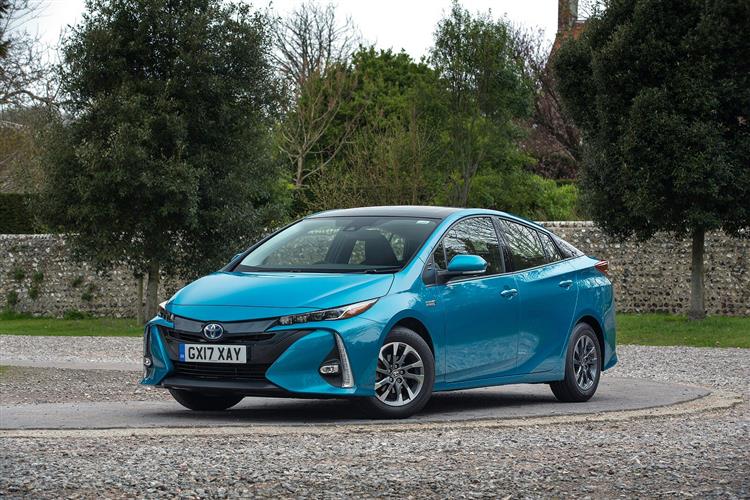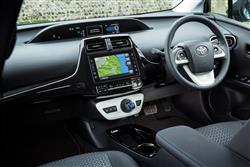How will you view?
This is a sample, and will stop after 30 seconds.
THROTTLE WIDE AND SAY R (some text hidden) SECTIONED_new_toyotapriusplug-in_2022
By Jonathan Crouch
Introductionword count: 138
These days, Toyota is ramping up its full-EV offensive but very first plug-in Toyota was a hybrid, the Prius Plug-in, initially launched in 2012, then introduced in this second generation XW50 form in 2016 with an update three years later. It proved to be a very credible contender in the growing market for plug-in hybrid models and can in this form run up to 34 miles on pure electric power (more than twice as far as the first generation model), with EV power up by 83% over that original car thanks to a more sophisticated Dual Motor Drive System. It's the faintly unbelievable WLTP-rated figures though, that could sell you on this car: fancy up to 235.4mpg on the combined cycle and up to 28g/km of CO2? Thought so. Let's check this car out as a used buy.
Modelsword count: 7
5-door hot hatch [2.0 VTEC petrol turbo]
Historyword count: 212
A little forgotten today is the fact that it was Toyota who were first to develop the whole concept of Plug-in hybrid motoring. And between 2017 and 2022, the brand offered a sophisticated family option in this segment, this car, the MK2 Prius Plug-in. Perhaps the reason we don't necessarily associate Toyota with PHEVs is that the company's initial contender in this class, the first generation 'XW30'-series version of this Prius Plug-in launched back in 2012, was so relatively uncompetitive. Not only was it prohibitively expensive but it would only at best travel around 15 miles on all-electric power. Not good enough. So Toyota went away and in 2016, came up with something better in the form of this far more competitive second generation XW50 version. This MK2 model immediately matched the class standard for all-electric driving range, doubling its potential EV distance to 34 miles and developing far more power from its larger lithium-ion battery thanks to technological improvements in three key areas: battery development, maximised EV driving performance and increased battery recharging speed. The car also handled better and looked far smarter with its second generation Prius styling. Toyota gave it a few more upgrades in 2019 to make it safer and better connected. It sold in form until late-2022.
What You Getword count: 494
Toyota decided to make this MK2 Plug-in Prius look a little different to its self-charging showroom stablemate. At the front, changes to this PHEV variant included prominent acrylic grille treatment flanked by thin, ultra-compact four-LED adaptive headlamp units. The vertical corner daytime running light strips that flank the fog lamps are unique to this Plug-in variant too. The rear's also a little different, the cross-sectional shape of the “double-bubble” rear screen carried into the curve of the rear spoiler. LED rear light clusters are integrated in the extremities of that spoiler, with strips that flow towards the central Toyota badge. And, as at the front, unique vertical light strips feature at each corner. In profile the changes are less easy to spot, the Prius Plug-in distinguished by its longer rear overhang, lower cowl and rear spoiler heights and model-specific, two-tone 15-inch alloy wheels, designed to provide extra brake cooling. Inside, there are fewer changes over the standard hybrid model, though the dual 4.2-inch TFT meter in the revised instrument panel features PHEV-specific graphics. Otherwise, the dash is very similar, with copious amounts of shiny piano black plastic trim on the lower centre console, the centre stack, the steering wheel and the doors. As usual with a Prius, there's a clear structural arrangement of layered information which places the driver's meters at a distance and the displays closer at hand. Lots that you'll need to know to maximise energy returns can be found in the 'Information' section of this upper screen, offering read-outs you flip between using buttons on the steering wheel. All the more conventional infotainment functions can be found on the eight-inch infotainment display that dominates the centre of the fascia and incorporates navigation, a reversing camera and a useful Energy Monitor so you can see what's being powered by what. In the rear there's seating for three - which we only make a point of saying because earlier versions of this second generation model inconveniently only gave you two seats separated by a centre console. A third seated person in the back would have to be on friendly terms with the other two but at least there's a relatively low central transmission tunnel, just above which is a 12volt socket (though in this day and age, a USB port would be more useful). Small bottle holders reside in the doors and a centre armrest retracts to reveal the usual couple of cup holders. Out back, you've to make a few compromises for the PHEV tech. This was the first mass-production car to be fitted with a CFRP (carbon fibre reinforced plastic) tailgate and once you raise it, you'll find that the luggage deck has had to be raised by 160mm to accommodate the larger plug-in hybrid system. The result of course is that load space volume falls over an ordinary Prius - by 142-litres to a total of 360-litres. But that kind of compromise is par for the course with Plug-in hybrids.
To see the full road test text contact us on 0330 0020 227
Pictures (high res disabled)

.jpg)
|
.jpg)
|
.jpg)
| |||
.jpg)
|
.jpg)
|
.jpg)
| |||
.jpg)
|
.jpg)
|
.jpg)
| |||

|
Scoring (subset of scores)
Category: Hybrid, Plug-in, Electric & Hydrogen
| Performance | |
| Handling | |
| Comfort | |
| Space | |
| Styling, Build, Value, Equipment, Depreciation, Handling, Insurance and Total scores are available with our full data feed. | |



